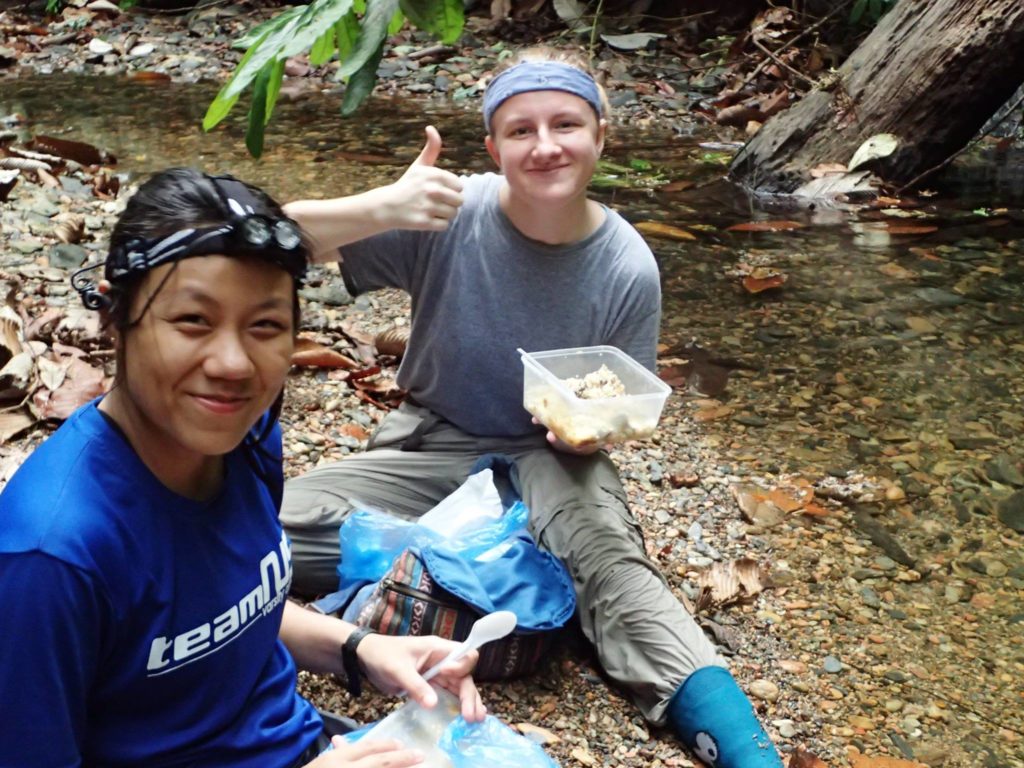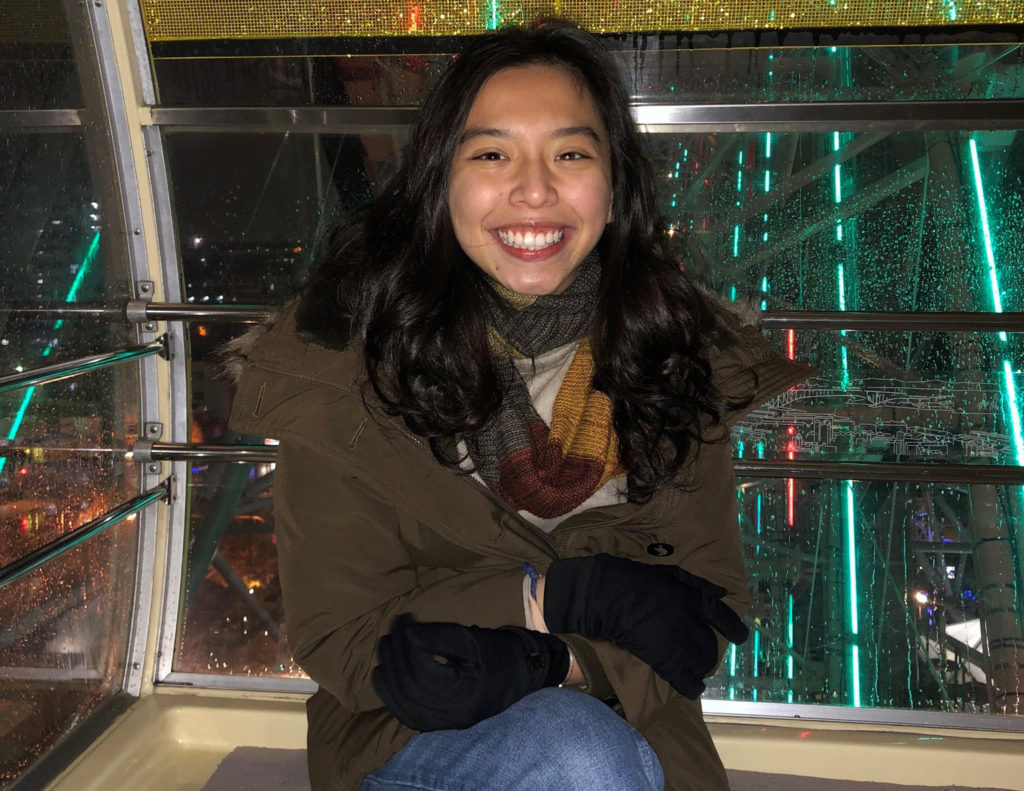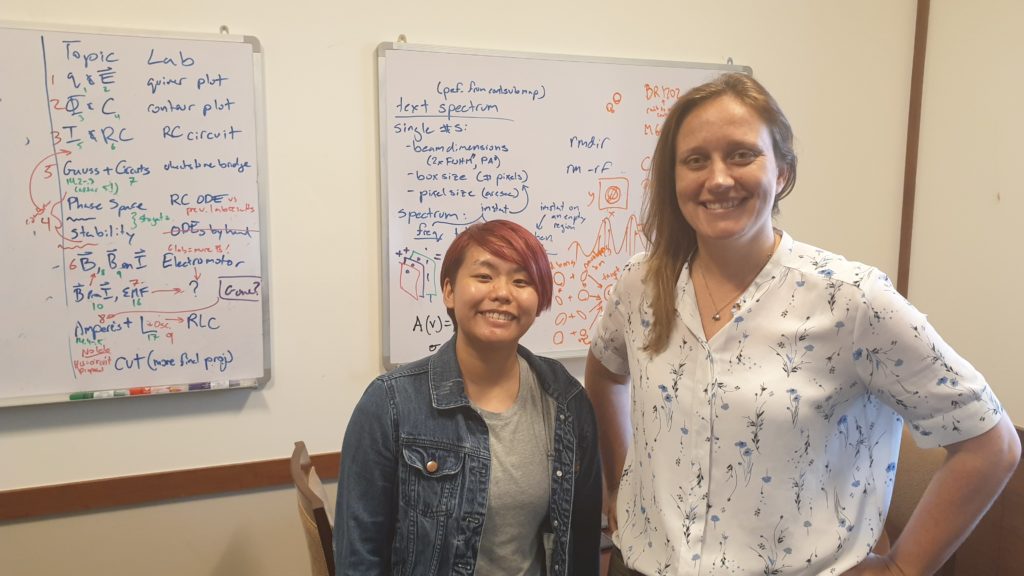Best of both worlds: Students participate in science research outside their major
“Being outdoors exposed me to another world that I never really interacted with in my day-to-day city life,” Crystal Yong (Class of 2019) noted from Juneau, Alaska, where she is currently volunteering for a research programme. “It made me appreciate nature and all that it holds more than I did before.”
Crystal is no stranger to nature’s extreme environments: she participated in ecological research with Assistant Professor of Science (Life Sciences) Philip Johns, which mainly involved wading through the undergrowth in the jungles of Brunei in search of a particularly loud species of cricket. “At about 115 decibels, it is one of the loudest insects on earth,” said Asst Prof Johns.
“We were trying to determine whether acoustics can be used to distinguish certain species of crickets,” said Crystal. “Species delineations in Southeast Asia have so far only been done using morphology [physical characteristics]. My role was mainly in field work, where I caught the crickets and recorded acoustic data.”
 “I was offered the opportunity to do this research so I figured, why not?” Image provided by Crystal Yong (left).
“I was offered the opportunity to do this research so I figured, why not?” Image provided by Crystal Yong (left).
The research opportunity developed from Crystal’s experience as a first-year student in her Week 7 Learning Across Boundaries (LAB) programme[1] led by Asst Prof Johns. Fascinated by the creature, Crystal decided to pursue the research project with Asst Prof Johns, who teamed up with “world-class cricket expert” Tan Ming Kai, a Research Assistant at the Department of Biological Sciences at the National University of Singapore (NUS), then a graduate student.
One of Crystal’s favourite memories was the process of catching the crickets without damaging their burrows. “We thought the burrows were acting as amplifiers for their calls, so besides capturing the cricket, we also wanted to get a plaster cast of its burrow to understand their shape,” she said. “We took a long time figuring out the mechanics of how to extract the cricket without damaging its burrow – there really is no ‘instant recipe’ to tackle the many challenges that field work presents.”
The team eventually found that certain members of this group of Southeast Asian crickets could indeed be distinguished by their calls. Crystal’s work on the cricket recordings and subsequent data contributed to a paper authored by Mr Tan, which was published in the journal Systematics and Biodiversity, and recently nominated for the Taylor & Francis Outstanding Paper Prize 2018. Both Crystal and Asst Prof Johns were listed as co-authors on the paper.
Crystal said that she pursued the research because she liked learning about things outside of her declared major. “Given the interdisciplinary approach of the Environmental Studies major, understanding the approaches of other specialised fields is crucial.” she said. “But apart from that, I enjoy learning about how other specialised academic fields operate and approach the world.”
Another student who yearned for exposure in other academic fields is Gena Soh (Class of 2020). A Philosophy major, Gena worked on biology research with Assistant Professor of Science (Biology) William Piel, studying the correlation between spider heart rate and the intensity of web vibrations they experienced. The project was part of the Summer Research Programme organised by the Centre of International and Professional Experience (CIPE).
“I was studying Argiope versicolour,” she said, describing the arachnid more commonly known as the St Andrew’s cross spider, so named for the way it rests in its web with pairs of legs outstretched in the shape of an X. “Intense web vibrations are a signal to the spider that prey is caught in its web, and so I wanted to see if more intense vibrations triggered a surge in the spider’s metabolic activity – so that they could run over and consume their prey.”
Gena was responsible for figuring out a way of consistently producing varying levels of vibrations to the spider webs in the experiment, as well as video-recording the spider’s heart rate through a microscope to counts its heartbeats. “Unfortunately, the results were inconclusive,” she said, “which is just how it is sometimes.”
The project actually developed from an earlier study, which was tangled in its own web of unfeasibility. “Our original intention was to examine a variant Chilean spider species, which was rumoured to live for 10 years – 8 years longer than a typical spider of its kind,” she explained. “It buries itself for weeks at a time, and we wanted to know if it could reduce its heart rate while buried to save energy. Unfortunately, our initial efforts to measure its heart rate were foiled because the spider’s thick epidermis made it difficult for our sensors to pick up the heartbeats – that’s why we started this project, which experimented with using video data instead.”
Gena was fascinated by the College’s insectary – where live insects are kept and reared. “I had no idea that the College housed such a facility,” she said. “It was like a whole new world to me.” It was there that Gena and Asst Prof Piel examined their specimens in microscopes, and where she learnt how to identify spider anatomy: “how to find the heart, what the blood vessels around it are called, and similar things,” she said.
 “I really learnt to appreciate insects and spiders as a whole, which put me more in touch with the natural world.” Image provided by Gena Soh.
“I really learnt to appreciate insects and spiders as a whole, which put me more in touch with the natural world.” Image provided by Gena Soh.
For Gena, the project was an avenue for her to supplement her passion for creative writing. “Since I spent so much time looking down microscopes, I’m more attuned to the small details in the natural world,” she said. “Some time after working on this project, I was walking around MacRitchie Reservoir and I was drawn to the veiny linings that ran across the translucent wings of a bug. These small moments stay with me, and I hope will emerge in my writing later on.”
Reni Chng (Class of 2021) is an Arts & Humanities major and Physical Sciences minor, who approached Assistant Professor of Science (Physics) Chelsea Sharon after the latter mentioned in her course on general physics that she was looking for student researchers. Two semesters later, Reni is helping Asst Prof Sharon study the clouds of gases that fuel star formation using radio telescope data, also as part of the CIPE Summer Research Programme.
“We’re trying to find out whether actively-feeding supermassive black holes slow down star formation in early galaxies,” Reni explained. “Star formation was a lot more frequent in the early stages of the universe, and it has become less frequent as time passed. We’re using a synchronised array of radio telescopes – the Atacama Large Millimeter/submillimeter Array (ALMA) – to observe radio waves to see if the supermassive black hole is affecting the gas.”
Reni’s responsibilities involve using software to convert the data collected by the telescope array into visual spectral lines, as well as modelling the pattern of emission lines to determine whether the star-forming gas clouds are affected by shock waves or X-rays produced by the supermassive black holes at the centre of their respective galaxies.
“There was quite a steep learning curve,” said Reni, who did not have any prior knowledge or experience in radio astronomy. “Then one day, I was working with another student researcher and it slowly dawned on me that we were using all these technical terms that I wouldn’t have understood just a few weeks ago. It was a cool moment where I realised I had actually learned a lot in this process.”
 “Both of the fields I study are primarily about looking through different lenses to find perspectives that are useful,” said Reni Chng (left), who is a student researcher for Assistant Professor of Science (Physics) Chelsea Sharon (right). Image provided by Reni Chng.
“Both of the fields I study are primarily about looking through different lenses to find perspectives that are useful,” said Reni Chng (left), who is a student researcher for Assistant Professor of Science (Physics) Chelsea Sharon (right). Image provided by Reni Chng.
Prior to joining Yale-NUS, Reni had studied mainly science subjects. While being keen to explore various artistic media, Reni did not want to forgo the option of pursuing Physics or Engineering at university level, and had so far taken roughly equal numbers of courses in Arts & Humanities and Physical Sciences, with plans to continue taking courses in both fields.
“I mean, we’re trying to figure out the story behind star formation in early galaxies and piece it together in a way we can understand,” said Reni. “It isn’t all that different from other stories people create to make better sense of the world around us.”
[1] In the Week 7 LAB programme, first-year students, faculty and staff engage in learning projects of up to a week that explore themes of the Common Curriculum outside the confines of a traditional classroom. Week 7 LAB projects are faculty-generated initiatives that are organised in collaboration with the Centre for International & Professional Experience (CIPE).





